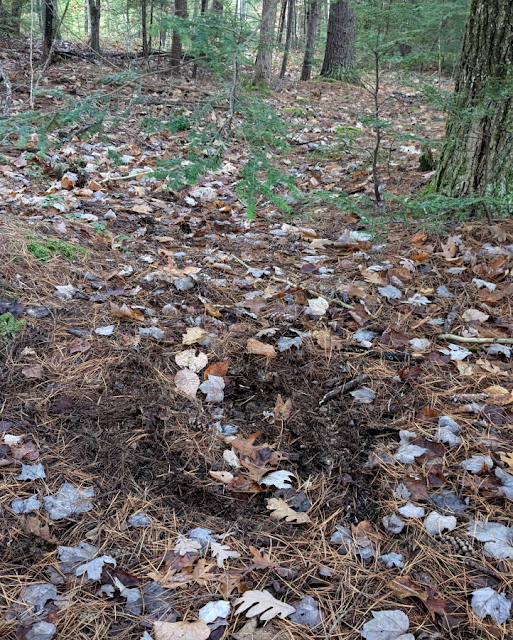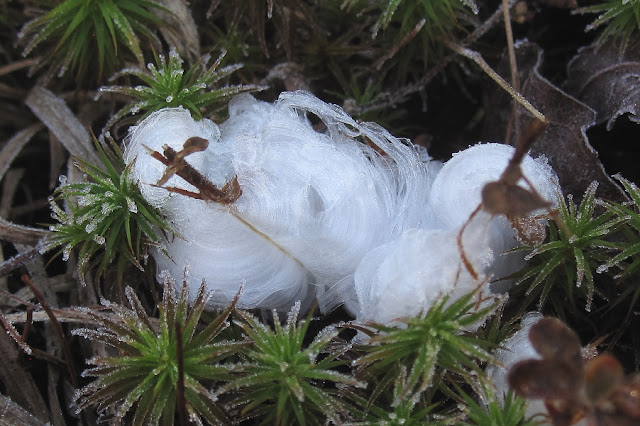Much of New Hampshire's rugged beauty is the result of glacial activity that took place some 12,000 years ago as the last ice-age retreated. The Laurentide Ice Sheet, which was over two miles thick at its peak, retreated north over thousands of years, with its last remnants in New Hampshire melting approximately 10,000 years ago, but the specific time frame of its final demise here is uncertain.
As the glacier pushed south from the artic it cut deep gouges which formed many of our lakes, and sliced off parts of mountains forming ledges with fine views. It also scoured off soil and dragged and rolled large chunks of rock with it in a continental-size rock tumbler. As the planet warmed, less snow fell, the glacier slowed its movement, then stopped. As it melted it left those boulders wherever they were at the time, sometimes far from their original formation. These are know as glacial erratics and can be found throughout much of New Hampshire, including all around Lake Wicwas.
 |
| An erratic beside the Arbutus Hill Trail in Hamlin. |
 |
| A carefully balanced boulder, delicately placed by the glacier. |
The most famous erratic in New Hampshire is the Madison Boulder which is as big as a house.
 |
| Madison Boulder. White Mountains New Hampshire photo. |
The largest erratic I've found in Meredith is in Hamlin, right beside the Yellow Trail to Crockett's Ledge. If you hiked that trail you've surely noticed it.
f.JPG) |
| This is right at the junction of the two Yellow Trails heading up to Crockett's Ledge. |
A professor at Plymouth State University, Professor Simon Pendleton, and one his students, are studying glacial history and they're using these glacial boulders to determine more accurately just when the last glacier retreated north through the Lakes Region. Prof. Pendleton has identified a small number of boulders in the Hamlin Town Forest to study as part of his research. Each boulder was selected based on criteria that makes it most suitable for testing, and the stewards of the Town Forest worked with Prof. Simon on the selection process and approved the rocks for sampling.
 |
| One of the boulders selected for research. |
The dating process involves chipping off a small piece of the boulder to bring it to the lab for testing. The testing process is long and detailed, but involves crushing the stone to a fine dust, separating the small amount of beryllium within the rock, and then analyzing the beryllium for a specific isotope which is created by cosmic-rays from the sun. By measuring the amount of this isotope they will know how long the boulder has been exposed to sun, thus providing a date for when the glacier melted which left the boulder exposed to the suns cosmic-rays. For those interested, you can learn more about beryllium-10 Cosmic-Ray Exposure Testing here.
Of course, this isn't actually how old the rock is - the White Mountains were formed 100-120 million years ago - but it will give us a better idea of when the last ice sheet left the Lakes Region and allowed our current fauna and flora to attain a foothold. This data will also help us understand how our planet and its present-day glaciers will behave in our current warming climate, as well as the impact it will have on Earth's existing inhabitants.
It will takes weeks to process the samples, and then many more to analyze and interpret the data, but when the results are published I'll report them here. Professor Pendleton has also offered to give a presentation on the results, and lead a guided tour to the testing sites in the Hamlin Town Forest to show us the specific boulders tested, talk more about the testing and its significance, and let us know how long ago you would have been standing at the edge of a glacier.
Moving forward in time a hundred or so centuries, let's see some elements of that renewal of life that have survived. This week a couple of female Common Mergansers spent a rainy day on the lake fishing.
It makes me wonder if the reason we haven't seen many migratory ducks since the Wood Ducks early on is because we've had such good weather. Perhaps they only stop by the Lakes Region when weather is poor and they want a short day of travel.
I've also had some fun, though fleeting glimpses of deer, mink, and otter. The otters numbered three, and were out frolicking in the lake as they made their way from one shore to another. Hopefully there will soon tracks in the snow to follow their path. The mink I saw was swimming right against the shoreline, hopping up onto land here and there to follow a scent or something else of interest, then right back into the lake. No picture of him either, but here's one from a similar scene a few years ago.
Mink are just one of the thousands of creatures that have returned and survived for all these years since the area was swept clean of life thousands of years ago.
 |
| An AI generated image of New Hampshire shortly after the Laurentide Ice Sheet retreated. |
We can be thankful it will be long time before North America is swept clean again.
Happy Thanksgiving!
 |





















f.JPG)






















